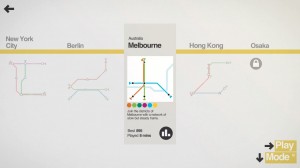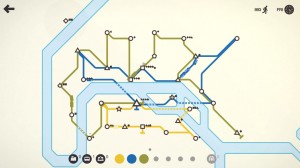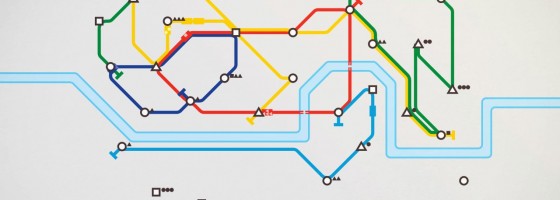Mini Metro is a puzzle game built around the task of creating effective tram stations and lines in various cities around the world using a minimalist aesthetic. While it might not look like much at first glance, Mini Metro is one of those games that can pull you in for hours on end. With that said, this train system doesn’t have much in terms of legs (or cars) in a manner of speaking.
Point A to Point B:
There isn’t any real story to Mini Metro or a campaign, instead, your goal on each map is to create a tram system to move passengers to their intended goal. Each map is based on a real world location which is set each time you play. During a play, new stations will randomly appear on the map represented by shapes.
Creating a new line is as simple as dragging the mouse pointer around and then watching the train move. The rules state that lines can’t cross each other and the same color line can’t connect to a station more than at two points on a single station. As you play, more stations will appear, forcing you to either create other lines or redraw connections to extend an existing line.
At the end of each week of in-game time, you’ll gain a bonus reward and then have a chance to choose a second one based on two randomly selected choices. These rewards allow you to improve your lines, such as adding additional cars to a train, more trains, tunnels/bridges to go across water and etc.
When a station starts to fill up with passengers, you’ll get an alert via a timer that appears on the station; if you don’t move passengers off of it in time, the game is over and your final score will be tailed up based on the number of moved passengers. And that’s about it for Mini Metro in terms of gameplay.

The different maps offer some form of progression, but they don’t change the basic gameplay or mechanics at all
There are optional challenges that you can do to unlock extreme mode which makes your tram lines permanent and a sandbox mode if you want to just keep playing and making the largest tram system ever.
I do have to give a shout out to the aesthetics which mirrors the art style of classic subway systems and is a good example of how a clean aesthetic can help pull you into a game. Mini Metro is one of those games where you can just tune out and play for hours on end if you get into it, but for people looking for more to do, this is a quick train ride.
Stuck at the Station:
Mini Metro encompasses both what’s good and bad about minimalistic experiences: It’s simple enough that anyone can jump in and has a great “pickup and play” feel to it, but it doesn’t have much beyond that initial play. The main reason to play Mini Metro is to either go for the extreme challenges or for score chasing.
There are no forms of progression, in-game awards or meta-game content or simply growth to the game mechanics. While yes, this is great for someone who wants a game to zone out to for several hours, the lack of gameplay growth prevents me from enjoying the game more.

Mini Metro is easy to learn and is a great game if you are looking for something to relax to while playing
A few weeks ago I wrote a post about one-time game design or games where I could only play them once before putting them away; Mini Metro is one such game. That doesn’t mean that this is a bad game by any means, but it just feels really limited in ways to play it.
Hopping the Turnstile:
Mini Metro is going to be one of those love it or hate it games: If it hooks you, you’ll be spending hours trying to beat yours and your best friends’ scores and going after the extreme challenges. If it doesn’t, you’ll play it for about 20 minutes and never look at it again.
This is a game that you can tell that the developers wanted to make a very specific experience in terms of content and aesthetics and Mini Metro works on that level, but its missing gameplay and/or progression motivators to keep someone invested; who isn’t just interested in getting the best score.
For more on Mini Metro, you can check out this spotlight video I made on it.


